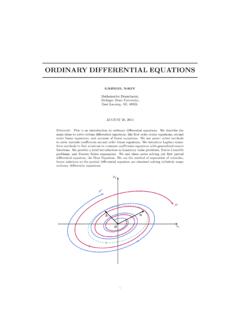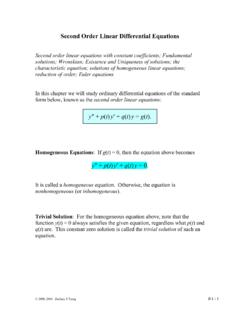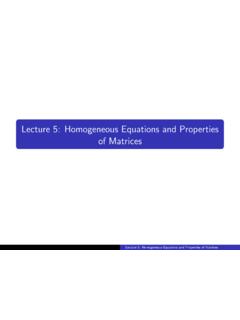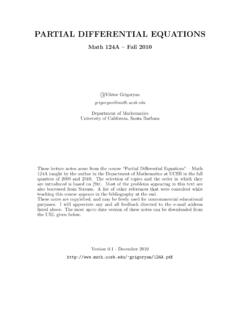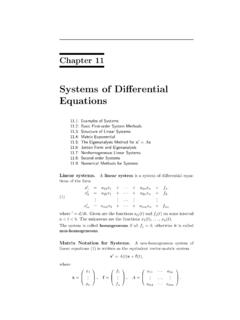Homogeneous Equations
Found 9 free book(s)ORDINARY DIFFERENTIAL EQUATIONS
users.math.msu.edulinear equations, separable equations, Euler homogeneous equations, and exact equations. Soon this way of studying di erential equations reached a dead end. Most of the di erential equations cannot be solved by any of the techniques presented in the rst sections of this chapter. People then tried something di erent.
Chapter 2 Ordinary Differential Equations
www.et.byu.edu2.2.4 Homogeneous Equations Homogeneous function Homogeneous equation Reduction to separable equation – substitution Homogeneous functions in Rn 2.2.5 Linear 1st order ODE General solution Solution of IVP 2.2.6 Special Equations Bernoulli Equation Ricatti equation Clairaut equation Lagrange equation Equations solvable for y
Second Order Linear Differential Equations
www.personal.psu.edureduction of order; Euler equations In this chapter we will study ordinary differential equations of the standard form below, known as the second order linear equations: y″ + p(t) y′ + q(t) y = g(t). Homogeneous Equations: If g(t) = 0, then the equation above becomes y″ + p(t) y′ + q(t) y = 0. It is called a homogeneous equation ...
Lecture 5: Homogeneous Equations and Properties of Matrices
dkatz.ku.eduA system of linear equations is said to be homogeneous if the right hand side of each equation is zero, i.e., each equation in the system has the form a 1x 1 + a 2x 2 + + a nx n = 0: Note that x 1 = x 2 = = x n = 0 is always a solution to a homogeneous system of equations, called the trivial solution. Any other solution is a non-trivial solution.
Higher Order Linear Differential Equations
www2.math.upenn.eduHomogeneous equations The general solution If we have a homogeneous linear di erential equation Ly = 0; its solution set will coincide with Ker(L). In particular, the kernel of a linear transformation is a subspace of its domain. Theorem The set of solutions to a linear di erential equation of order n is a subspace of Cn(I). It is called the ...
6.4.9 Solutions to homogeneous systems of linear equations
ece.uwaterloo.ca• If you were to solve the corresponding homogeneous system of linear equations, the constant vector in the solution is zero: Solutions to homogeneous systems of linear equations 11 6 3.9 §· ¨¸ ¨¸ ¨¸©¹ 2 22 1.4 01 0 x xx · ¸ ¸ ¸¹ x 0 0 0 §· ¨¸ ¨¸ ¨¸ ©¹ 2 22 1.4 1 00 x xx · ¸ ¸ ¸ ¹ x Example
PARTIAL DIFFERENTIAL EQUATIONS
web.math.ucsb.eduThe linear equation (1.9) is called homogeneous linear PDE, while the equation Lu= g(x;y) (1.11) is called inhomogeneous linear equation. Notice that if uh is a solution to the homogeneous equation (1.9), and upis a particular solution to the inhomogeneous equation (1.11), then uh+upis also a solution to the inhomogeneous equation (1.11). Indeed
Systems of Differential Equations - University of Utah
www.math.utah.eduThe system is called homogeneous if all fj = 0, otherwise it is called non-homogeneous. Matrix Notation for Systems. A non-homogeneous system of ... 526 Systems of Differential Equations corresponding homogeneous system has an equilibrium solution x1(t) = x2(t) = x3(t) = 120. This constant solution is the limit at infinity of
Chapter 7 First-order Differential Equations
www.sjsu.eduLearn to solve typical first order ordinary differential equations of both homogeneous and non‐homogeneous types with or without specified conditions. Learn the definitions of essential physical quantities in fluid mechanics analyses. Learn the Bernoulli’s equation relating the driving pressure and the velocities of ...
